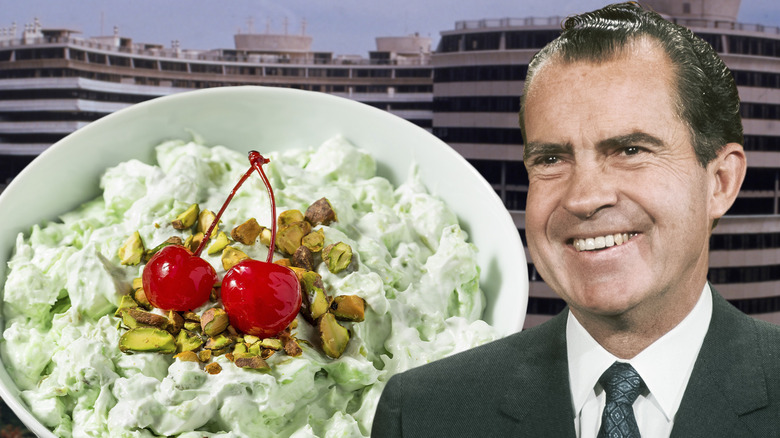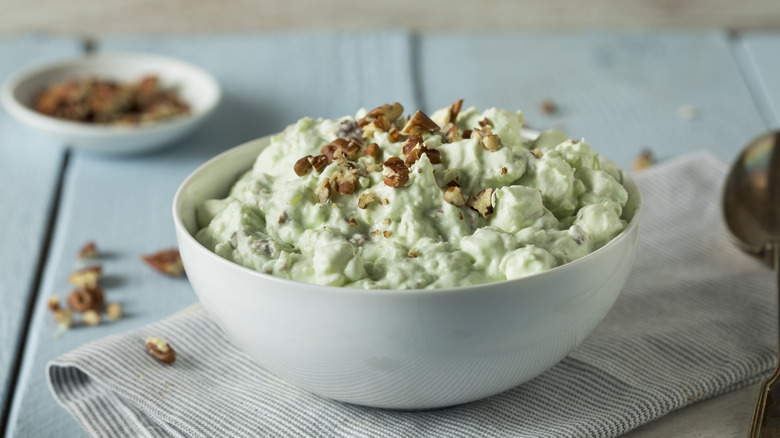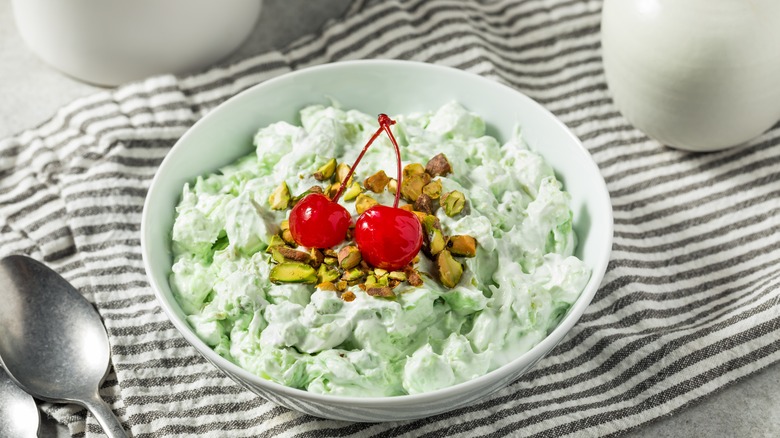Watergate Salad Has Nothing To Do With The Scandal, So Why Is It Called That?
If you're planning a trip to Washington, D.C., there are a few spots that you simply must visit. If you're a history buff, you can visit Ford's Theatre (and maybe catch a glimpse of Lincoln's ghost) or eat at Martin's Tavern in Georgetown, where John F. Kennedy Jr. proposed to Jackie. Then again, if historic scandals are your forte, you must make a stopover at the infamous (and luxurious) Watergate Hotel – just don't ask for a bowl of Watergate salad. Though the salad bears the moniker of the landmark hotel, the establishment does not sell — and never has sold — the creamy, green dessert. And no, the salad doesn't have anything to do with the 1970s political scandal involving former President Richard Nixon, either. So how, then, did Watergate salad get its name?
You wouldn't be completely amiss to assume that the Watergate salad might have gotten its name from the hotel. After all, the Waldorf salad, for example, takes its name from the hotel at which it originated. And the Watergate salad does have a strong midcentury vibe that echoes that of the hotel, which first opened in the1960s. After all, what's more mid-century than a salad made from pudding mix, mini marshmallows, whipped topping, and pineapples? However, the link between these two 20th century icons is more fluff than fact, and the history behind the Watergate salad is just about as foggy as the Potomac River on which the Watergate Hotel sits. To understand the roots of the green stuff, and its scandal-ridden name, it's key to first look to the food scene of the 1970s, and Kraft Foods' push for pistachio pudding.
A scoop on the fluffy green Watergate salad
Now to dig into the Watergate salad's culinary lineage. Watergate salad falls under the general umbrella of Jell-O salads, as the pistachio pudding used to make the dish is made by the Jell-O company (owned by the company now known as Kraft Heinz). Now the stuff of jokes and barbs, Jell-O (or gelatin) salads were once a staple in American cuisine. These dishes, which combine instant gelatin or pudding mix with various ingredients to create both sweet and savory foods, gained massive popularity in the United States in the latter half of the 20th century. They were both convenient and easy to prepare, making them staples in households where women were taking on more and more labor both in and out of the household.
In the 1950s, cookbooks flooded the market with recipes for Jell-O salads, some of which came from Kraft Heinz itself. And often, these recipes would combine multiple products created by the same company. Watergate salad is one such case, though your won't find the dish under that name in any vintage cookbooks. Kraft first introduced the dish under the name "pineapple pistachio delight" in 1976, the same year that the company introduced its pistachio pudding mix. And Kraft would continue using this name for the recipe until 1993, when it officially changed its name to Watergate salad. This recipe echoes similar pistachio pudding recipes that were already circulating at the time, but Kraft's recipe soon became popular among home cooks, thanks to its fluffy texture and sweet taste.
How the Watergate salad was named
So how did pineapple pistachio delight become Watergate salad? The most popular theory is that Watergate salad took its name from the similarly pistachio-based Watergate cake. Because the two recipes share a similar green hue and nut-flavored base, it's easy to see how home cooks would view the salad as simply a different iteration of the cake. However, this still leaves some unanswered questions — how did the Watergate cake get its name? Well, the name's popularity likely comes from a story published in the Washington Post in 1976, two years after the end of the Watergate Scandal — and one year after the Post first published a recipe for the cake. According to The Washington Post, a 1970s story published by the paper read, "[a] new Watergate crisis is sweeping the Washington area." According to this story, the crisis " ... stems from the growing popularity of a recipe for a concoction called 'Watergate Cake,' which demands large quantities of powdered pistachio pudding mix."
The writer noted in this cheeky column that the reason for the cake's name was unclear even then — but the article cemented the name and association with the scandal. Soon after that, Kraft's recipe for pineapple pistachio delight was introduced. And soon, the two similar desserts took on the same name: Watergate. It seems that Watergate's only real tie to the hotel (or the political scandal) is by association. It's a culinary game of telephone that, disappointingly, has no real ties to the political intrigue with which it is often associated. So you might want to pack away those bright green dreams of Watergate salad on your next trip to D.C.


